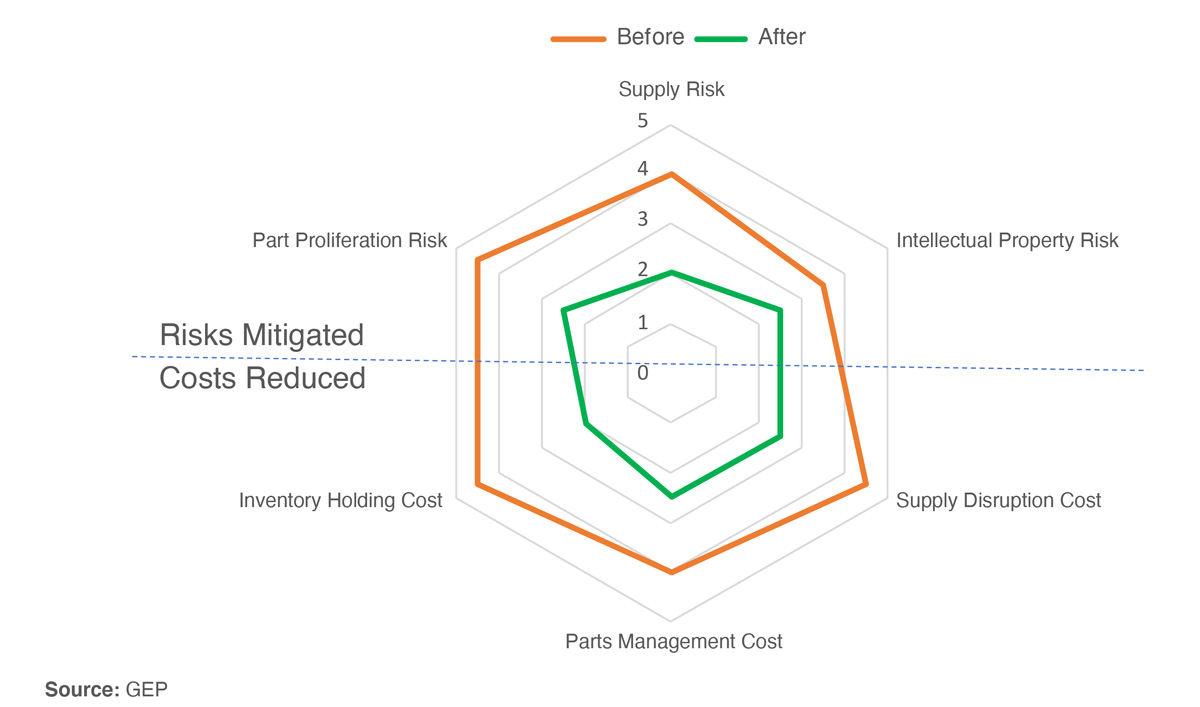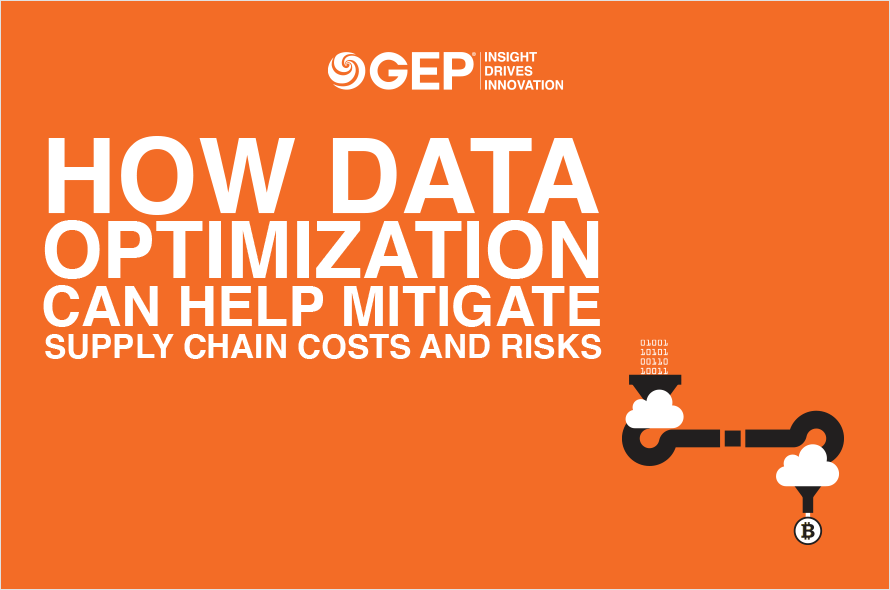If you’re fixated on managing supply chain risk right now, you’re in good company.
But what about your costs? They’re lurking. Right there on the balance sheet. And you can’t ignore them.
Our latest paper — How Data Optimization Can Help Mitigate Supply Chain Costs and Risks — outlines the steps you must follow to manage risk and costs simultaneously. The paper also reveals just how one major multinational transformed its data practices and became resilient in the toughest supply chain environment.
What’s Inside:
- The real cost of failure among systems, stakeholders and collaborators
- Why enhancing data flows is critical to standardization
- How data standardization can boost collaboration and improve decision-making
This paper is a must-read for supply chain leaders. Learn how you can maximize data to drive business transformation.
In 2020, supply chain priorities understandably shifted from cost optimization to risk mitigation. At some point in 2022 and beyond, emphasis will swing back to cost optimization, and supply chain executives need to be ready.
How should supply chain leaders prepare for the return to a cost-containment approach? They need to invest in fundamental improvements with an eye toward long-term supply chain resilience. This will ensure that when management does come looking for cost reductions, they don’t have to reactively eliminate redundancy and inventory levels that were built for a good reason during COVID-19. Rather, they will have transformative opportunities to reduce costs and mitigate risks.
Optimization isn’t limited to physical supply chains. As supply chains have become increasingly technology-driven, optimizations in the cloud can have a very real impact on the ground. Enhancing the flow of supply chain data can lay a powerful foundation to transform the supply chain and achieve cost reduction and risk mitigation simultaneously.
Optimizing Supply Chain Data Flow Mitigates Risks While Reducing Costs

Lack of Data Centralization Hampers Collaboration
Our experience across many large, multinational corporations with multiple business units illustrates the importance of data centralization. In one example, an organization decentralized its direct materials procurement function to serve each business unit's and region’s unique needs more effectively.
While that approach provided needed flexibility, there was a of harmonization across regions in aspects such such as spend categories, consolidation of spend, suppliers and SKU names. At multiple facilities across the globe, all purchasing became site-based. Part classification was not done at the point of release of parts. In addition, multiple engineering systems were used to release parts, with separate systems for specifications, drawings and manufacturing processes.
Procurement, engineering and manufacturing were not collaborating on areas such as new part introduction, and multiple disconnected ERP systems stored data in their own formats.
There were widespread implications of this approach, including:
- Multiple personnel across the enterprise purchased the same items unknown to each other.
- Each subdivision had a different part number and material code structure. Some ERPs did not store the material code at all, and just sent the drawings for the part number to the suppliers. This can make invoice matching difficult and manual.
- Enterprise data couldn’t be leveraged for top-down analyses because invoice data did not have material codes, and each SKU could have multiple codes.
The business impact of this approach included increased costs and risk:
- When one division encountered a supply issue, they sought an alternative supplier, not knowing that another division had excess inventory. The alternative supplier came at potentially higher cost and/or lower quality due to the urgency.
- Direct costs were likely higher as the enterprise was not leveraging its global buying power in supplier negotiations.
- The lack of uniformity also potentially increased indirect overhead expenses such as inventory costs and part management and invoice matching costs.
Three-Pronged Approach: Collaboration, Standardization and Optimization
The solution for the organization’s challenges addressed three primary dimensions simultaneously:
| Data Standardization | Organizational Collaboration | Systems Optimization |
|---|---|---|
|
Using a substantial one-time effort, master data for all SKUs was standardized into a single pattern. Standardization was built in at source for sustainability. |
A good balance was struck between decentralization (for better alignment with the BUs) and central oversight to own the strategy and standardization. |
Consolidating to one global ERP instance was not feasible in a reasonable cost and time frame. So, the focus was on quick point solutions which enhanced the data flow and cleansing. |
| Examples | ||
|
Material codes for all SKUs were standardized into one pattern, which followed a form-function -application format with 5+ elements. A single standard was applied across all ERP systems — the effort here was significant, but it was well worth it. |
Raw material procurement teams remained decentralized to serve the business effectively, but Centers of Excellence (COEs) were established for each spend area. The firm could thus control the strategy and data effectively. This allowed the team to leverage spend, remove price arbitrage, build COEs and share best practices across facilities for parts that were manufactured using similar processes. |
Accurate assignment of a part to a buyer was accomplished using a combination of a rule-engine and an AI module. A single engineering system was used for release of all parts. It could store all process specs, part specs and drawings in one place. Workflow automation and approvals were used to ensure new data is entered automatically and/or double-checked at source. |
Benefits: Visibility Gained While Simplifying Parts Management
The three-pronged solution described above led to multiple benefits for the organization:
- Supply risk was proactively mitigated, leveraging the clear visibility to enterprise-wide inventory and availability of consolidated, pre-qualified preferred supplier lists owned by the COE.
- Intellectual property such as drawings was safeguarded in an access-controlled repository instead of being distributed by email with purchase orders.
- Proliferation of identical items across BUs was drastically reduced.
- As the data was streamlined, inventory holding costs were reduced due to consolidation of inventory. Parts management became drastically simpler and more automated.
Having all SKUs in the organization named using a single convention and having greater confidence in the quality of data created immense visibility and clarity. The team continues to find new ways to improve operations.
Enablers in the Cloud Have Significant Impact on the Ground
Below are some other examples of foundational technology enablers that unlock significant opportunities for supply chain optimization:
| Foundational Enablers | Short-Term Opportunity | Long-Term Opportunity |
|---|---|---|
|
Order collaboration and inventory visibility across extended supply chain |
Efficient/automated order process |
Unified supply resilience strategy using extended supply chain |
|
Unified data lake for all supply chain data |
AI/ML predictive analytics to improve up-time and reduce costs |
Autonomous, real-time supply chain decision-making for responsiveness Digital twin of supply chain for scenario analysis and risk mitigation |
|
Merge IT and OT into single seamless system |
Common IT road map eliminate duplicate investments |
Software-driven factory connected and responsive to CRM order-flow |
Conclusion
Optimizing supply chain data flows can have a transformative impact on the physical supply chain. To drive the next level of standardization, efficiency and visibility in the physical supply chain, the transformation must now start at the data layer. The solution for each situation will be different, but the next generation of supply chain technology offers built-in foundational enablers.
Transforming your supply chain’s data flows can be a long journey, especially for large, multinational supply chains, but point solutions within this space can be your highest ROI.
TURN IDEAS INTO ACTION. TALK TO GEP
GEP helps enterprise procurement and supply chain teams at hundreds of Fortune 500 and Global 2000 companies rapidly achieve more efficient, more effective operations, with greater reach, improved performance, and increased impact. To learn more about how we can help you, contact us today.

Pranav Padgaonkar
Senior Director, Consulting, GEP
Pranav is a Sr. Director in the Consulting Practice, and brings with him 17 years of extensive experience covering a broad spectrum of procurement and supply chain capabilities. He leads large consulting engagements focused on cost reduction, using digital transformation, strategic sourcing and supply chain optimization to deliver transformative results.

